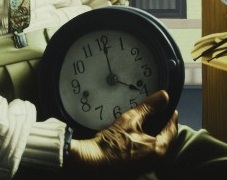Perhaps it’s a cliché to illustrate the dawning of a new year with a painting titled “Time.” But Max Ferguson’s gorgeously detailed work is so evocative, I just couldn’t resist.

Max Ferguson
“Time,” 2006
Oil on panel
36 x 36 in.
© Max Ferguson. Crystal Bridges Museum of American Art, Bentonville, Arkansas. Photography by Edward C. Robison III.
We can’t help thinking about the passage of time as we roll the calendar over from one year to the next. In a very pragmatic way, of course, nothing is particularly different between 11:59 p.m. and 12:00 a.m. on December 31. But on the other hand, from one moment to another, perhaps everything is.
Ferguson’s painting offers us a moment of old-world stillness: an elderly man going quietly about his work, unhurried, taking time to focus on the task at hand and apply a pride of craftsmanship and pleasure to the job. The clocks in the image point to this seeming suspension of time; although, as no two clock faces show the same hour, they hint also at the relativity of how we perceive time. What speeds by all too quickly for me may drag painfully for you.
In our twenty-first-century daily lives as helpless passengers on a raging torrent of ever-present information, this sort of focus is difficult to achieve. Stillness just seems to take too much effort: we have to paddle hard against the current to snatch the briefest hiatus from the maelstrom. Our lives are moving so quickly we barely have time to steer, much less to appreciate the moment we occupy now.
And now.
And now.
But art demands otherwise of us. Art is slow. It commands attention—interrupts that runaway train of obligations and reminders and worries. It wants us to stand still, in this moment, and take it all in.
The old clockmaker in Ferguson’s painting offers us a vision of that zen-like focus on presence. His stillness and peace draws us in, just by virtue of his unhurried focus on this everyday task.
Ferguson has been greatly influenced by the work of the Dutch Masters. He is inspired by both their great attention to detail and their focus on secular, everyday subjects. “What appealed to me tremendously,” he explained, “was the everyday aspect of it and this idea of taking the ordinary and making it extraordinary, taking the mundane and giving it a sort of holy quality.”
Someone once said of his work: “nothing is happening but everything is happening.” And you can feel that in the painting as you look at it—there’s a sense of story spinning out on either side of this frozen moment. But there’s also a sense of significance found in the mundane moment itself.
As we stand on the cusp of a new year, it’s worth pointing out that the mundane is what makes up 99% of our lives. If, like the clockmaker in Ferguson’s painting, we can manage to “be here now,” as the zen master said… to notice those moments as they happen—think of how much more living we’ll gain from our lives!
Here at Crystal Bridges, we’re pretty sure that great works of art help return our focus to the now by drawing us in to the moment of looking. It’s like the snap of a rubber band on your skin: bringing you back into the moment, forcing you to get out of your head and look. Let the future and the past take care of themselves–just be present with the art.
 So, for the year ahead, take some time to slow down and notice what’s around you. Come into Crystal Bridges’ galleries and spend a good long half hour just sinking deeper and deeper into your favorite work of art. Take your time. Go outside and walk the trails. Pause to notice the stark, beautiful architecture of the forest in this season of stillness. Sit down in the Tulip Tree Shelter and be quiet long enough for the birds and other wildlife to forget you’re there. Remember that only by being present can we thoroughly experience and enjoy that extra 99%.
So, for the year ahead, take some time to slow down and notice what’s around you. Come into Crystal Bridges’ galleries and spend a good long half hour just sinking deeper and deeper into your favorite work of art. Take your time. Go outside and walk the trails. Pause to notice the stark, beautiful architecture of the forest in this season of stillness. Sit down in the Tulip Tree Shelter and be quiet long enough for the birds and other wildlife to forget you’re there. Remember that only by being present can we thoroughly experience and enjoy that extra 99%.
Come look with us. And have a happy New Year.







